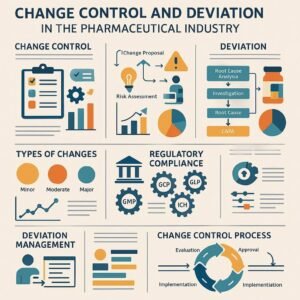
Change control manages planned modifications to processes or systems through a formal approval process, ensuring quality and risk mitigation. In contrast, a deviation is an unplanned, unexpected departure from established procedures that requires investigation and often leads to Corrective and Preventive Actions (CAPA) to address the issue and prevent recurrence. Change Control Vs Deviation in […]
Change control manages planned modifications to processes or systems through a formal approval process, ensuring quality and risk mitigation. In contrast, a deviation is an unplanned, unexpected departure from established procedures that requires investigation and often leads to Corrective and Preventive Actions (CAPA) to address the issue and prevent recurrence.
No, deviation refers to an unplanned or unintended event that occurs during production or testing, while change refers to a deliberate modification or adjustment to a process, system, or product.
According to the ICH (International Council for Harmonisation) guidelines, change control refers to the systematic management of changes in a regulated environment to ensure that modifications do not negatively affect the quality, safety, or efficacy of the product.
Change Control Example: Changing a supplier for raw materials due to improved quality or cost.
Deviation Example: A manufacturing batch is out of specification because of a temperature control failure during production.
In the pharmaceutical industry, change control is a formal process used to manage any modifications to processes, systems, or products to ensure they don’t compromise product quality, safety, or regulatory compliance.
Changes in a project are controlled through a change management process that includes assessing the impact, documenting the change, obtaining approval from stakeholders, and ensuring proper implementation and monitoring of the change.
Change control is a structured process used to evaluate, approve, and implement changes to a product, process, or system to ensure that the change does not negatively affect the quality, safety, or compliance of the product.
You May Like
| Aspect | Change Control | Deviation |
|---|---|---|
| Definition | A formal process for managing changes to any aspect of a process, system, or product. | An unintended, unexpected event that deviates from approved procedures, processes, or specifications. |
| Purpose | To ensure that changes are made systematically, evaluated, and approved to maintain product quality and compliance. | To identify, investigate, and rectify unplanned events or errors to ensure compliance and quality standards are maintained. |
| Initiation | Initiated proactively due to process improvements, system upgrades, or new requirements. | Initiated reactively after a deviation or non-conformance has occurred during manufacturing or testing. |
| Scope | Typically involves planned, controlled changes (e.g., changes in raw materials, equipment, or procedures). | Typically involves unplanned issues or non-conformances in processes, equipment, or materials. |
| Documentation | Requires detailed documentation of the proposed change, including risk assessments, approvals, and implementation plans. | Requires a deviation report detailing the event, root cause, corrective actions, and impact assessment. |
| Approval Process | Must be approved by relevant stakeholders (e.g., quality, regulatory, production) before implementation. | Requires approval to investigate and correct, but often handled by quality assurance or the affected department. |
| Impact on Operations | Aims to improve or optimize operations and ensure compliance with current regulations and standards. | Focuses on identifying and correcting issues to prevent recurrence and maintain compliance. |
| Examples | Changing a supplier, modifying a manufacturing process, or introducing new equipment. | A batch failing quality control tests, equipment malfunction, or process error during manufacturing. |
| Regulatory Focus | Ensures that changes do not affect product quality, safety, or compliance with regulatory requirements. | Ensures that deviations do not lead to patient safety risks or affect the integrity of the product. |
| Corrective Actions | May require updates to procedures, validations, or training. | Corrective and preventive actions (CAPA) are taken to resolve the cause of the deviation and prevent recurrence. |
| Impact on Product Quality | Change control aims to enhance or maintain product quality by introducing improvements or necessary adjustments. | Deviation may negatively impact product quality and must be corrected to avoid potential risks to consumers. |
Quick Links